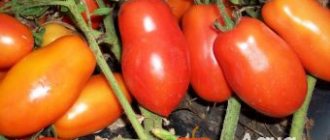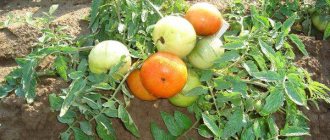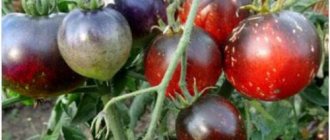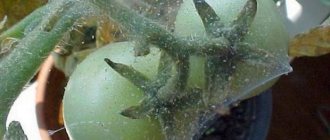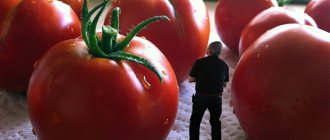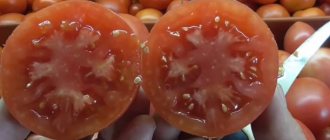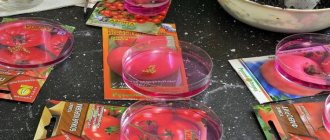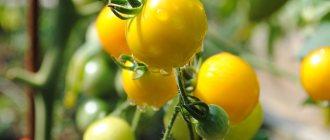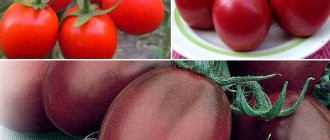Main characteristics
The originator of the Red Rooster variety is the Gavrish seed company. It was included in the State Register of Breeding Achievements in 2015. The Red Rooster tomato is recommended to be cultivated in all regions of our country; it feels equally good with any growing method - with or without shelter.
The main advantages of the variety:
- ultra-early ripening period - the ripe fruits of this tomato can be tasted already 85 days after germination, cool weather can delay this period by 10 days, but even in this case, when planting 60-day-old seedlings, ripe fruits are harvested in about a month;
- a low bush - up to 80 cm, of a determinant type, it finishes its growth on its own, making the gardener’s work easier, since there is no need to pinch the tomato plant, but it still needs shaping; according to gardeners, the Red Rooster tomato shows the best yield if on the bush 3 stems left;
- strong tomato bushes are heavily loaded with harvest, so they will have to be tied up;
- The fruits of the Red Rooster tomato are large, their average weight is about 200 g, but with good care it can be more;
- The color of the fruit is bright red, the shape is flat-round, the stalk has slight ribbing;
- The taste of tomatoes of the Red Rooster variety is sweetish with a slight sourness - this is what real tomatoes should have;
- The purpose of Red Rooster tomatoes is universal: you can make a delicious salad from them, pickle them in jars, pickle them, make winter preparations by cutting them into pieces or boiling tomato paste; any product will have excellent taste;
- The Red Rooster tomato is suitable for market sales - it has an excellent presentation, excellent taste, and is well transported.
One of the main characteristics of the Red Rooster tomato is its unpretentiousness. It is capable of setting fruit in any weather and, subject to all care rules, provides a harvest of up to 3 kg from one bush. In the description of this tomato variety, it is necessary to note such a feature as resistance to diseases, which is very important, especially in rainy summers.
The video will tell you more about this tomato variety:
How to care for tomatoes in a greenhouse
- Water every 3 days early in the morning or after sunset.
- Plant honey plants in the greenhouse or install sweet baits. This will attract bees and wasps to the greenhouse for pollination.
- Maintain humidity no more than 70% to prevent tomato pollen from sticking together.
- Ventilate the greenhouse every day to prevent fungal diseases of plants and to let in bees.
- Apply potash and phosphorus fertilizers every 2 weeks during the flowering period.
Caring for seedlings in a greenhouse
Advantages and disadvantages of the variety
Why are Red Rooster tomatoes becoming more and more in demand? The following important advantages contribute to this:
- ease of care, thanks to which even novice gardeners can successfully cope with growing vegetables;
- optimal yield indicator, because up to 7 kilograms of crop can be harvested from one bush;
- decent presentation and resistance to transportation, as a result of which tomatoes are ideal for cultivation and further market sale;
- pleasant taste characteristics: moderate sweetness is felt and slight sourness is noted;
- universal culinary use: preparing delicious salads, pickling and pickling.
Tomatoes of the Red Rooster variety have numerous important advantages that determine the possibility of obtaining a decent harvest in the shortest possible time. There are practically no disadvantages, which is why many gardeners boldly choose Red Rooster tomatoes.
Top dressing
The Red Rooster tomato takes feeding well. We apply fertilizer regularly, at intervals of 10 or 14 days. We make sure that feeding is given in sufficient quantities. However, we also do not allow excessive application of fertilizers. A week after planting the seedlings, gardeners suggest adding a mixture of useful substances that contain potassium. The elements that tomatoes need are in the ash. We saturate the soil with phosphorus and nitrogen fertilizers in the spring, when we prepare the soil for planting.
It is not recommended to use substances that contain chlorine.
Tomatoes of this crop are resistant to plant diseases and are not afraid of late blight. However, manufacturers recommend treating plants with preparations that contain copper.
Related article:
Growing tomato seedlings at home
Features of cultivation, planting and care
We recommend sowing the seeds of this tomato for seedlings 55-60 days before the intended planting in the ground. Picking of seedlings is in the phase of the first true leaf. Don't forget about feeding tomato seedlings. Planting seedlings in a permanent place is recommended when the threat of return frosts has passed. Planting scheme
: 40 x 50 cm.
Further care for tomatoes consists of timely watering, fertilizing with complex mineral fertilizer, pinching and preventive measures to protect against diseases and pests.
Feeding and picking
We feed the seeds using complex fertilizers.
When the phase of the first true leaf begins, we pick the seedlings. Picking is carried out to extract weak plants. Also, after this procedure, the growth of the root system is stimulated. After the formation of 4-6 healthy leaves, the seedlings are placed in larger containers.
Related article:
Growing indoor tomatoes at home on a windowsill
Tomato Red Rooster: characteristics and description of the variety
Tomato is a vegetable that can be found in every garden. Some people prefer to grow them only in a greenhouse, rightly believing that the harvest there is larger and the fruits are larger. But for most greenhouse varieties, the ripening time is far from the earliest. Many people plant seedlings in open ground, selecting early-ripening varieties that yield a good harvest. Most often, their fruits are small and are more suitable for canning. But among them there are exceptions, one of which is the Red Rooster tomato. Reviews from those who have already planted it and harvested it are positive. Why did gardeners like him so much? We will compose a complete description of the variety, as well as provide the main characteristics in order to understand its advantages. The photo shows Red Rooster tomatoes.
Main characteristics
The originator of the Red Rooster variety is the Gavrish seed company. It was included in the State Register of Breeding Achievements in 2015. The Red Rooster tomato is recommended to be cultivated in all regions of our country; it feels equally good with any growing method - with or without shelter.
The main advantages of the variety:
- ultra-early ripening period - the ripe fruits of this tomato can be tasted already 85 days after germination, cool weather can delay this period by 10 days, but even in this case, when planting 60-day-old seedlings, ripe fruits are harvested in about a month;
- a low bush - up to 80 cm, of a determinant type, it finishes its growth on its own, making the gardener’s work easier, since there is no need to pinch the tomato plant, but it still needs shaping; according to gardeners, the Red Rooster tomato shows the best yield if on the bush 3 stems left;
- strong tomato bushes are heavily loaded with harvest, so they will have to be tied up;
- The fruits of the Red Rooster tomato are large, their average weight is about 200 g, but with good care it can be more;
- The color of the fruit is bright red, the shape is flat-round, the stalk has slight ribbing;
- The taste of tomatoes of the Red Rooster variety is sweetish with a slight sourness - this is what real tomatoes should have;
- The purpose of Red Rooster tomatoes is universal: you can make a delicious salad from them, pickle them in jars, pickle them, make winter preparations by cutting them into pieces or boiling tomato paste; any product will have excellent taste;
- The Red Rooster tomato is suitable for market sales - it has an excellent presentation, excellent taste, and is well transported.
One of the main characteristics of the Red Rooster tomato is its unpretentiousness. It is capable of setting fruit in any weather and, subject to all care rules, provides a harvest of up to 3 kg from one bush. In the description of this tomato variety, it is necessary to note such a feature as resistance to diseases, which is very important, especially in rainy summers.
The video will tell you more about this tomato variety:
Photo of red rooster tomatoes
Tomato care
All tomatoes, even ultra-early ones, are grown through seedlings. At least 55 days must pass between germination and transplantation of seedlings into the ground, which usually happens in early June. During this time, it will have about 7 leaves, the first cluster of flowers will form and, perhaps, will already bloom.
Growing seedlings
There is a lot of hassle with growing tomato seedlings:
- seed calibration;
- etching them in Fitosporin, peroxide or potassium permanganate;
- sowing in specially selected loose and breathable soil;
- keeping tomato crops warm and dark, and newly emerged sprouts cool and in bright light;
- providing weekly tomato seedlings with warmth - about 23 degrees, maximum lighting, timely watering with non-cold water, at least 2 fertilizing with full mineral fertilizers.
But you still need to pick when the kids have only 2 sheets and transfer them to a liter container when there are already 4 or 5 of them.
What if you try to do without seedlings? Many gardeners will be surprised - the tomato is a heat-loving crop, you can’t sow it in the ground early, and if sowed late, the crop simply won’t have time to form. All this is true, but experienced gardeners have long come up with a way to grow tomatoes without seedlings, and more than one. Of course, it is not suitable for every variety. Their choice is limited only to ultra-early tomato varieties; hybrids are usually not suitable.
Growing tomatoes without seedlings
In ordinary, unprepared soil, the idea is doomed to failure from the start. You will need box beds with a wall height of at least 30 cm. Since the process of warming up the soil must begin when the ground has not yet thawed, all preparatory work is carried out in the fall. The bed should be located from east to west, the area should be illuminated by the sun all day long.
How to make box beds can be seen in the video:
What to do with the garden bed in spring:
- cover with film placed on the arcs. If there is still snow on the garden bed, it needs to be swept away; this can be done as early as the beginning of April. The film is chosen with a thickness of 150 microns; it will reliably protect the bed from frost;
- after 1-2 weeks, when the soil has warmed up, water the bed with a hot solution of pink potassium permanganate;
- prepare five-liter bottles by cutting off the bottom;
- choose a warm sunny day, mark the bed, making 2 cm indentations in it according to a 40x60 cm pattern with a diameter of about 10 cm;
- pour hot water into each cavity;
- Place tomato seeds in a circle, 4 seeds in each circle, sprinkle with a layer of soil about 2 cm thick, compact slightly with your palm. For seedless sowing of the Red Rooster tomato, only dry seeds are used.
- cover each circle with a cut bottle, lightly pressing it into the soil. Bottle caps are not unscrewed.
- cover the arcs with non-woven material, and on top with film, provide additional cover for tomatoes with film in case of severe frosts;
- When warm weather sets in, remove the caps from the bottles.
The emerging tomato seedlings are thinned out, leaving only one strong plant. The rest can be planted in a seedling bed or simply removed. Covers are removed from the garden beds when the return frosts have passed. Caring for seedless tomatoes in the summer should be the same as for those that were planted as seedlings.
There is another method, but it is available only to those gardeners who already have a Red Rooster tomato growing in the garden.
What is the essence of the method:
- in the fall we choose a large and healthy tomato, or maybe several, without signs of late blight and rot;
- we store them in a cool place until the onset of cold, but not frosty weather until approximately the end of October;
- we are preparing a bed for tomatoes, on which we will grow them next year, and straw mulch;
- Make a hole 15 cm deep in the ground, put a handful of rotted straw on the bottom and place a whole tomato. The tomato must be whole; there is no need to separate the seeds from it.
- fill the hole with rotted straw and mulch the top with a layer of humus. Salted or soaked tomatoes can also be used for planting if they have not been exposed to high temperatures.
- in the spring, as soon as the snow melts, we remove some of the humus, cover the bed with non-woven material and install arcs on which we throw the film.
Red Rooster tomato seeds that have undergone natural stratification and selection will germinate smoothly, and the plants will be strong and healthy. All that remains is to plant them.
There is also an intermediate method in which tomato seedlings are grown at home before picking, and then planted in a pre-prepared and heated bed covered with bottles.
Advice! When making such a pick, place the tomato plants no closer than 10-15 cm from each other, so that later it will be easier to plant them.
What are the advantages of such methods:
- no need to bother with growing tomato seedlings at home;
- tomatoes grow strong and hardened;
- plants do not stretch.
They also have disadvantages. Our unstable climate brings surprises in the form of rain in January and snow in June, and sometimes cold, cloudy summers. In the latter case, the entire crop on the bush will not have time to ripen; you will have to pick some Red Rooster tomatoes green and ripen them in the room. Preparing warm beds requires certain costs. When planting early, you should always be prepared to additionally cover the beds.
Outdoor care
To speed up the process of growth and ripening of tomatoes, you need to follow all agrotechnical practices:
- mulching the soil;
- watering with warm water. Drip irrigation is best.
- fertilizing once every ten days or every 14 days with complete mineral fertilizer with microelements;
- correct formation of plants with the removal of all unnecessary stepsons;
- timely treatments against late blight.
If everything is done correctly and on time, with any method of growing the Red Rooster tomato, it will give a good harvest of tasty, early and large fruits.
Igor, Tula
I have been planting the Red Rooster tomato for the second year now. A very unpretentious variety, easy to handle flaws in care. The tomatoes are large and tasty. I planted the seedlings early, the tomatoes managed to produce a harvest before late blight appeared. True, in order not to risk it, I picked the last fruits from the bush green. They ripened well, the taste was almost no different from those that ripened in the garden. Victor, Perm I planted Red Rooster tomatoes in a greenhouse, it’s more reliable. I liked the variety both in taste and size of the fruit. The soil in the greenhouse is fertile, and I looked after the tomatoes conscientiously. I managed to collect 3 kg of tomatoes from some bushes; I specially weighed the entire crop. I'm pleased with the variety. I collected my seeds for planting next year.
How to grow tomatoes
By June, the seedlings are ready to be transplanted into the ground. In greenhouse conditions, seedlings are planted 2 weeks earlier.
Landing
The soil is prepared 2 weeks before transplanting by digging and adding humus. They are transplanted into holes 15-20 cm deep, at the bottom of which a little sawdust or wood ash is first placed.
Planting pattern: 50 cm – distance between seedlings, 60 cm left between rows. For 1 sq. m place 3 plants in a checkerboard pattern. With this method, each bush receives a sufficient amount of light and is well ventilated.
After transplantation, the soil is compacted, watered with warm, settled water and the young bushes are left to get used to the new conditions for several days.
Further care
Regular watering is established no more than 2 times a week, water with warm, settled water at the root; tomato does not like watering leaves. Before fruiting begins, water abundantly, at least 5 liters of water per 1 seedling. When the ovaries form, watering is reduced, since excess moisture may cause the fruits to crack.
After watering, the soil is loosened, removing weeds with roots. Loosening saturates the root system with oxygen. To retain moisture in the beds, they are mulched with straw or peat.
This is especially important on dry days
The crop is fed three times per season: during flowering, at the time of ovary formation and during fruiting. A full complex of minerals or organic matter is used as fertilizers. Mineral fertilizers containing nitrogen are given 2-3 weeks after transplantation. Nitrogen helps plants grow green mass.
Fertilizers with a predominant content of phosphorus and potassium are given during the period of ovary formation and fruiting. Such fertilizing accelerates the ripening of fruits.
From organic matter, use mullein infusion or bird droppings in a ratio of 1:15. Such strong dilution is necessary so that the root system does not get burned.
Features of cultivation and possible difficulties
The indeterminate type requires mandatory staking of tall seedlings. The sooner you fix the stem to the support, the more powerful it will be formed. To do this, install a metal or wooden support next to each seedling and tie the stem to the support almost immediately after transplanting. In addition to the stem, fruit-bearing branches are fixed to the support as they grow.
The most convenient way of gartering is by fixing it to a trellis. Plants are fixed to a horizontally stretched wire with soft fabric tapes.
The culture needs regular pinching due to the large number of shoots. Stepchildren that have reached 5 cm are removed in the morning so that by the evening the wounds have time to heal. To prevent infection, the cut sites are sprinkled with ash or treated with a solution of potassium permanganate.
For maximum fruiting, the plant is grown in 1 or 2 stems.
Diseases and pests
Varietal characteristics include high resistance to diseases of the Solanaceae family. It is also immune to attacks from many pests. However, we should not forget about simple preventive measures, which include regular loosening, weeding, mulching and moderate watering. Agrotechnical rules recommend treating the beds with copper sulfate before planting tomatoes, which prevents fungal spores from developing.
In open ground, the Colorado potato beetle and its larvae are dangerous. Regular inspection of seedlings for the presence of the pest prevents the rapid proliferation of the parasite. Females lay larvae on the underside of the leaves, so careful inspection of the plants from all sides is necessary. If there are a lot of beetles, use the drug “Commander” or “Prestige”.
Reference. Treatment of plants with chemicals is carried out in sunny weather.
Agricultural technology for tomato cultivation
To grow the Red Rooster variety, the seedling method is used. Sowing seeds for seedlings is carried out 55-60 days before the expected date of planting in the ground. During this time, the seedlings develop 7 leaves and 1 flower cluster.
Before planting in the ground, the seeds are calibrated using an aqueous solution of kitchen salt. Poor quality material is always found in the upper part of the liquid container. The seeds are soaked in hydrogen peroxide or a solution of potassium permanganate and treated with a growth stimulator.
Seeds are placed in a container with a prepared soil mixture or substrate to a depth of 1 cm. After watering with warm water using a sprayer, the container is covered with glass or film to create a greenhouse effect. This ensures the friendly emergence of sprouts.
The container is placed in a warm place, and after the seeds are pecked, maximum illumination is provided. If necessary, artificially extend daylight hours to 16 hours using a fluorescent lamp.
For normal development of seedlings, maintaining temperature and soil moisture is required.
Watering the seedlings is carried out as the surface layer of soil dries. Plants require fertilizing with complex fertilizers.
At the stage of formation of 2 true leaves, seedlings are picked. This event allows you to cull weak plants and stimulate the growth of the root system. Seedlings with 4-5 true leaves are transferred to a large container.
Plants are planted in a permanent place after the end of the spring frost period. When planting, it is important to consider crop rotation. The best predecessors for tomatoes are parsley, carrots, cabbage, and cucumbers.
The soil for crops must be prepared in advance and organic fertilizers applied. The one who grew the Red Rooster variety recommends the optimal planting scheme. It provides for the placement of bushes at a distance of 40-50 cm from each other.
To speed up the process of crop ripening, it is important to follow agrotechnical practices. Watering the crop should be done with warm water at the root. Uniform distribution of moisture is ensured by the drip method.
To prevent the top layer of soil from drying out and control weeds, mulch with fiber or organic materials. The plant responds well to fertilizing, so it is recommended to apply fertilizer every 10-14.
Although the crop is resistant to the effects of late blight, for preventive purposes the bushes are treated with preparations containing copper.
Further care
We cultivate tomato plants strictly according to the instructions. Water with lukewarm water at the bottom of the plant near the roots. It is better to use a drip irrigation system for watering. The moisture will spread evenly under each bush of the plant. This can prevent excessive soil moisture or drying out.
Related article:
Tomato Andromeda F1 - characteristics and description of the variety
To improve soil properties and protection, you can cover the land with mulch. This is one of the best agricultural practices to ensure plant health. In addition to protecting against weeds, mulching enriches the soil with useful elements.
Rules for growing the variety
Initially, the seed material is planted for seedlings. To do this, they are sown in the substrate in separate containers to a depth of about 1 centimeter. Then the substrate is sprayed from a spray bottle and the first shoots are expected to appear. To accelerate the growth of vegetable crops, the containers are covered with glass. A similar event is held in March. Transplantation to a permanent location is recommended after 50-60 days.
Tomatoes are planted in separate pots after the first true leaves appear. Then you need to wait for the moment when the tomato seedlings grow.
Seedlings are transplanted into open ground only after they have grown. It is recommended to first take the seedlings outside so that they can successfully adapt to new conditions. At the same time, spring frosts should recede and the soil should warm up, because the subsequent harvest depends on this.
Tomatoes are planted according to a 40x50 centimeter pattern. This planting scheme guarantees an optimal harvest.
In the future, constant care of Red Rooster tomatoes will be required. What tasks should gardeners successfully cope with?
- It is recommended to actively work with the soil. For example, you need to mulch the soil and remove weeds. This determines how successfully air will flow to the plant and whether it will be able to absorb all the necessary nutritional components for its growth.
- Proper formation of tomato bushes with the obligatory removal of stepsons is mandatory. Only in this case can you count on improving the harvest.
- Watering in the morning or evening, in cloudy weather, is mandatory. Watering is carried out approximately once every 5 days. It is advisable to use warm water and a drip system.
- Fertilization is recommended. It is advisable to fertilize tomatoes once every 14 days. It is advisable to give preference to mineral complexes with all the necessary microelements.
- Prevention of tomato parasites and diseases is considered mandatory. Initially, the use of chemicals is allowed, but soon only folk remedies are allowed. Prevention must be timely.
Growing Red Rooster tomatoes requires a responsible approach to obtain a decent harvest.
Galina:
“I have been planting Red Rooster tomatoes for several years in a row. The unpretentiousness of the variety makes me very happy. In addition, it is possible to obtain large and tasty tomatoes. The most important thing is to follow the basic principles of agricultural technology and carry out all the necessary measures in a timely manner.”
Julia:
“I grow Red Rooster tomatoes in open ground because I’ve gotten the hang of it. The harvest is always not only large, but also truly tasty. I’m sure that I will continue to grow the Red Rooster variety.”
If you grew Red Rooster tomatoes, please write whether you liked them or not. What was the yield and taste of the fruits like under your climatic conditions? How do you rate the variety? Briefly describe the advantages and disadvantages of this tomato and give your assessment. If possible, attach a photo of the entire bush or individual fruits you grew to your comment. Thank you!
Your reviews of the Red Rooster tomato and additions to the description will help many gardeners evaluate this variety and decide whether it is worth planting or not.
You can see other interesting varieties and hybrids of tomatoes with photos, descriptions and reviews in our Tomato Catalog. Enjoy watching.
Ekaterina Traverina, 51 years old, Krasnodar
I always keep track of new tomatoes for open ground. I chose the Red Rooster tomato variety based on the description. The fruits grow smooth and bright red. Modern varieties of crops are pleasant to grow; Red Rooster tomatoes are unpretentious and resistant to characteristic tomato diseases. The description for the variety stated that the fruits are suitable for canning, but we ate almost all the tomatoes fresh. The pulp is very pleasant to the taste.
Daria Smirnova, 36 years old, Yaroslavl
I chose the Red Rooster tomato variety because of its early ripening period. Tomatoes in our region do not always have time to ripen on the bush. And as you know, they are the most delicious. The Red Rooster variety lived up to expectations. She grew them, however, not under temporary shelters, but in a greenhouse. The bush is strong, the harvest is large. The tomatoes taste pleasant, medium density, multi-chambered. The color is bright, each weighing about 160 g. I took the variety into my collection.
Reviews
Galina:
“I have been planting Red Rooster tomatoes for several years in a row. The unpretentiousness of the variety makes me very happy. In addition, it is possible to obtain large and tasty tomatoes. The most important thing is to follow the basic principles of agricultural technology and carry out all the necessary measures in a timely manner.”
Julia:
“I grow Red Rooster tomatoes in open ground because I’ve gotten the hang of it. The harvest is always not only large, but also truly tasty. I’m sure that I will continue to grow the Red Rooster variety.”
New products from the company “Gavrish”
The main task that the specialists of the Gavrish company set for themselves is to provide Russians with high-quality vegetable and flower seeds created in Russia. Breeding centers located in the city of Aleksin, Tula region, in the cities of Pavlovskaya Sloboda and Krasnogorsk, Moscow region, as well as in the city of Krymsk, Krasnodar region, have been able to successfully and quickly create seeds of popular varieties and hybrids for more than 20 years.
little fox
This large-fruited, mid-early, tall variety for film greenhouses will appeal to those who love rich harvests, excellent quality of bright fruits and simple formation into one stem with the removal of all stepsons. The fruits of the Fox variety tomato are bright orange, weighing up to 280 g, oval in shape. The fruits have delicate pulp and thin skin, which, oddly enough, is not prone to cracking.
Chick
This tall tomato is recommended for growing in film greenhouses, where the bush is formed into one stem. The variety is excellent for whole-fruit canning. The fruits have an original shape, reminiscent of a banana, and a bright yellow-orange color. The skin is thin, but quite durable. The pulp is sweet and sour. The average weight of tomatoes is 100-120 g.
Striped flight
Medium-sized cocktail tomato for growing in greenhouses, under temporary film covers and in open ground. Fruits weighing 30-40 g are arranged on long clusters of 20-30 pieces and are held very firmly and do not fall off. Ripe tomatoes acquire a chocolate-burgundy color with green stripes and a sweet and sour taste. The fruits are suitable for fresh consumption; they are good for pickling and pickling, both ripe and unripe.
Creme brulee
Medium-sized variety with white fruits. Suitable for growing in greenhouses and under temporary film covers. The fruits, weighing 200-250 g, are slightly flattened and sour in taste. Ideal for fermentation in barrels and preparing salads.
Black Pearl
A medium-early tall variety for growing in film greenhouses and in open ground with a garter to a high support (pergola, building roofs, high fence). Plants look good and can even be used as landscape design elements. Small Black Pearl tomato fruits (weighing 25-30 g) ripen, acquire a rounded shape, they have very delicate pulp and brown skin with a pinkish tint.
Detailed information about varieties and hybrids can be found on the website www.gavrishseeds.ru.
Pests and diseases
An early-ripening tomato yields its harvest before the August outbreak of late blight. It shows good resistance to other diseases, which will be higher if you follow preventive measures:
- Disinfect seeds, soil for seedlings, containers and all surfaces in the greenhouse before planting.
- Maintain crop rotation.
- Water the garden properly to avoid dampness.
- Apply balanced fertilizers.
- Carry out preventive spraying with home remedies, for example, a solution of whey with a couple of drops of iodine or a solution of wood ash, as well as Fitosporin.
Parasites affect the variety in the same way as other tomatoes. To protect against them, onions, basil, marigolds and other strong-smelling crops are planted next to the beds. If aphids or spider mites appear, the foliage is washed with soapy water; if there are a lot of parasites, insecticides are used.
